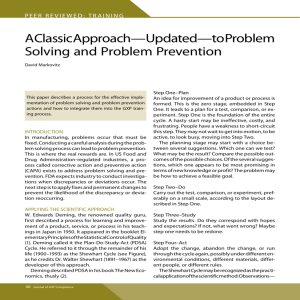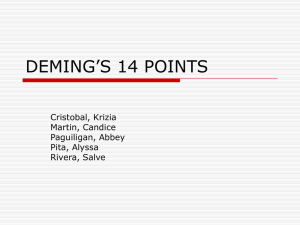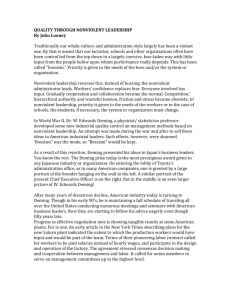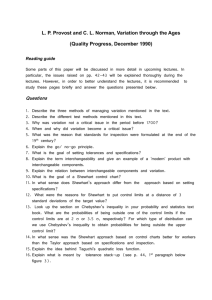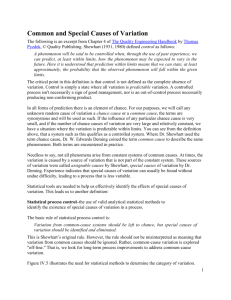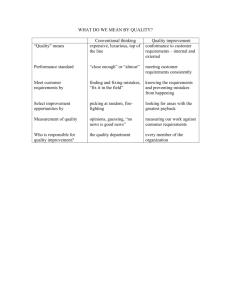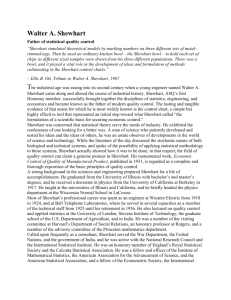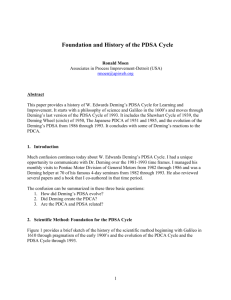Evolution of the PDSA Cycle
advertisement
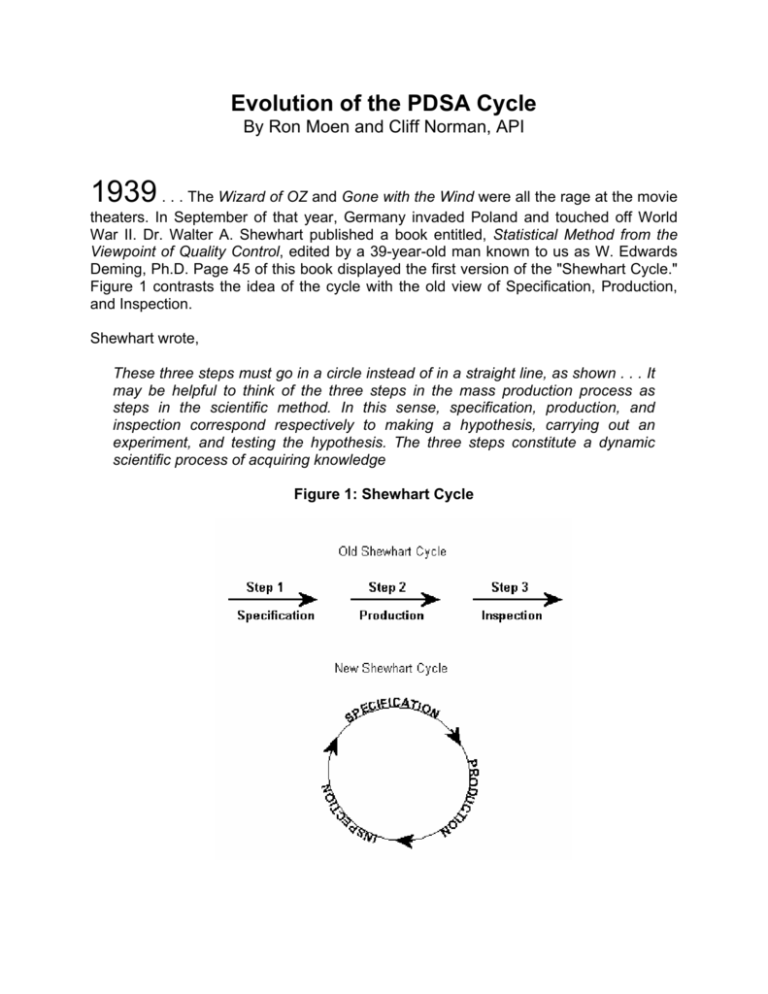
Evolution of the PDSA Cycle By Ron Moen and Cliff Norman, API 1939 . . . The Wizard of OZ and Gone with the Wind were all the rage at the movie theaters. In September of that year, Germany invaded Poland and touched off World War II. Dr. Walter A. Shewhart published a book entitled, Statistical Method from the Viewpoint of Quality Control, edited by a 39-year-old man known to us as W. Edwards Deming, Ph.D. Page 45 of this book displayed the first version of the "Shewhart Cycle." Figure 1 contrasts the idea of the cycle with the old view of Specification, Production, and Inspection. Shewhart wrote, These three steps must go in a circle instead of in a straight line, as shown . . . It may be helpful to think of the three steps in the mass production process as steps in the scientific method. In this sense, specification, production, and inspection correspond respectively to making a hypothesis, carrying out an experiment, and testing the hypothesis. The three steps constitute a dynamic scientific process of acquiring knowledge Figure 1: Shewhart Cycle When the Shewhart cycle was first proposed, it was used to describe the idea of Production Viewed as a System. As Dr. Deming taught the idea of the cycle over the next 50 years, the use of the cycle became much broader in its applications. Deming has always given credit to Shewhart for the idea of the cycle, but Deming has fostered the expansion of the idea to all areas for learning and improvement. The Shewhart Cycle was introduced to the Japanese in 1950. It was taught along with Dr. Deming's "Production Viewed as a System" model. By 1951, the cycle took on a new look (Figure 2) with a fourth part being added, and an additional step 5 to emphasize the iterative process of improvement. Figure 2: Shewhart Cycle - 1951 1. 2. 3. 4. Design the product (with appropriate tests). Make it; test it in the production line and in the laboratory. Put it on the market. Test it in service, through market research, find out what the user thinks of it, and why the non-user has not bought it. 5. Re-design the product, in the light of consumer reactions to quality and price. Continue around and around the cycle. In 1980, Dr. Deming was still emphasizing the four-step model from 1951 (Figure 2) in his seminars. On January 2, 1984 Deming put together the familiar cycle with the (1) Plan a change, (2) Try out this change, (3) collect data, and (4) study the data and circumstances. Figure 3 is a version of the cycle published in Out of the Crisis (1986). This version of the cycle was aimed at making specific improvements as opposed to the earlier versions that emphasized Production Viewed as a System. Deming (1984) advised, The job of any manager is to put everybody on a team for improvement of some activity. Each team will go through the Shewhart Cycle, over and over. A team will be reconstituted for another task when one is brought to a satisfactory conclusion, ready for action. Here Deming is clearly advocating the use of the cycle for everyone in the organization. During 1988, the cycle had evolved into what we know today as the "Plan - Do - Study Act cycle. Dr. Deming documented this version of the “Shewhart Cycle for Learning and Improvement” in 1992 in New Economics. In this version, the letters, P-D-S-A, are now part of the cycle. The cycle is now clearly aimed at all types of learning and improvement and can be utilized at any level, for an entire organization or for small improvements or changes. Figure 4 describes this version of the cycle. Figure 3: The Shewhart Cycle - 1986 Figure 4: PDSA From Deming’s, The New Economics Do – Carry out the change or test (Preferably on a small scale Study – the results. What did we learn? What went wrong? A P Plan a change or test, aimed at improvement S D Do – Carry out the change or test (Preferably on a small scale Associates In Process Improvement (API) has developed a version of the Shewhart cycle that emphasizes establishment of an objective, posing questions and making predictions in the PLAN step of the cycle. The cycle is the basic component of the Model for Improvement and is used to obtain knowledge, develop changes, test changes, and to implement changes. The Plan is carried out or data is collected to answer the questions posed by the Plan in the DO section of the cycle. In STUDY, the data are compared to the predictions for purposes of study and learning. Based on this knowledge, ACTION is developed or knowledge is updated. Figure 5 describes this view of the PDSA cycle. Where does PDCA fit in to the history? Deming taught the Japanese the version of the cycle that is depicted in Figure 2. Dr. Kano (1990) of the Japanese Union of Scientists and Engineers (JUSE) recently explained that Dr. Deming showed the Japanese an "eight-part wheel" during his 1951 lectures. Later Deming spoke in terms of "specification, production, and inspection." Dr. Kano explains, I communicated with Deming from 1977 to 1980, asking him about where he got the PDCA cycle. He sent me a book by Shewhart that had this chart (see Figure 1), but was surprised that we utilized the PDCA. He cannot understand our use of "Plan, Do, See, (Yes, "see" not "c") and then put things together. Now we say, "Plan, Do, See, (Yes, “see” not “c”) and then put things together. Now we say, “Plan, Do, Check, Action”---maybe Dr. Deming said "take action" and we missed the "take"! But at first we had the Plan, Do, See---just See, no action. At that time, people learn from Dr. Deming that the purpose of the data is not to "see," not to review, but to take action Figure 5: API - PDSA Cycle ACT PLAN - Object ive - What changes are t o be made? - Quest ions and predict ions - Next cycle? - Plan to answer the questions (who, what, where, when) STUDY - Complete the analysis of the data - Compare data to predictions - Summarize what was learned DO - Carry out t he plan - Collect the data - Begin analysis of the data Dr. Karou Ishikawa (1985), in discussing his memory of the PDCA cycle, reports that the PDCA cycle was taught in 1950, "How to use the cycle of Plan, Do, Check, Action to enhance quality." From Dr. Ishikawa's comments we can see that the cycle was taught as it applied to the whole production system, not for all levels of application as PDSA is applied today. Ishikawa credits Dr. Frederick Taylor with the use of the words “plan, do, see” to explain the concept of control. Ishikawa states, "To Japanese middle school students, it simply means: to look at, and that does not convey Taylor's meaning. So we have rephrased it as follows: "plan--do--check--action"(PDCA). This is what we call the Control Circle . . ." Drs. Shewhart and Deming credit C.I. Lewis with the evolution of their thoughts and ideas that formed what we know as the PDSA Cycle. John Dewey, a great thinker and philosopher is said to have influenced C.I. Lewis. Some of the first thinking on Plan-Do-Study may have originated with Dewey at the turn of the century in America. Baron & Sternberg (1986) describe a process of scientific inquiry that bridges everyday problem solving and the scientific method and they credit this thought process to Dewey (1933); The stages of the process . . . are: feeling difficulty, doubting what one has taken for granted, defining the problem, forming a hypothesis, inferring possible consequences, discovering a counter instance, revising and broadening the hypothesis to explain the counter stance, and applying the revised hypothesis to a life situation. One cannot read this description without thinking about the iterative process of the PDSA cycle. Summary - PDSA as we know it today has its roots in Dr. Shewhart's 1939 diagram. - The early use of the cycle was aimed at understanding "production as a system." - Dr. Deming broadened the use of the cycle to apply to all situations at all levels with the emphasis on learning and improvement. This evolution started during the early 1980's. - PDSA is the basis for the API Model for Improvement. Practioners in Japan use the cycle under the name "PDCA" with the same emphasis on learning and improvement. References Baron, Joan Boykoff and Sternberg, Robert J., Teaching Thinking Skills: Theory and Practice, W.H. Freeman and Company, 1986. Deming, W.E. Improvement of Quality. Paper. 1984. Deming, W.E. Out of the Crisis. MIT Press. 1986. Deming, W.E. The New Economics. MIT Press. 1993. Dewey, John. How we Think, Prometheus Books, 1933 Ishikawa, K.1985. What is Total Quality Control? 1985. Shewhart, W.A. Statistical Method from the Viewpoint of Quality Control. Department of Agriculture. 1939.

